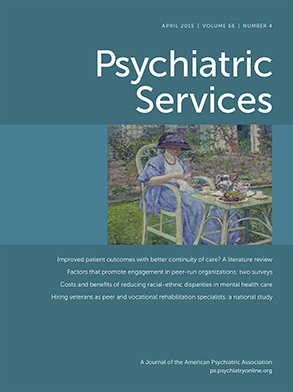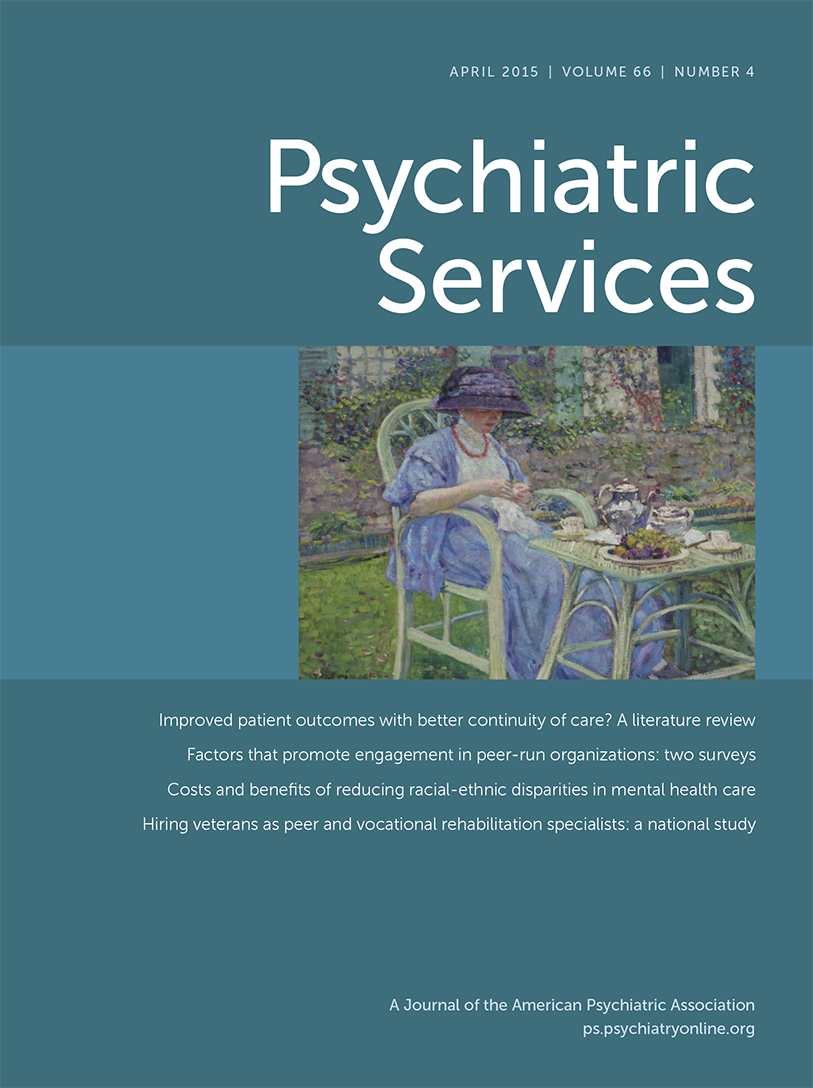Between 13% and 37% of school-age children and adolescents have mental health problems (
1–
3), and up to 80% of these children do not receive appropriate mental health services (
4,
5). Many studies have documented the discomfort that pediatric primary care providers (PCPs) experience when diagnosing mental health conditions, which has been shown to be a result of inadequate training and lack of confidence (
6–
8).
In New York State, Project TEACH (PT; Training and Education for the Advancement of Children’s Health) was developed to enhance PCPs’ knowledge and skills in the identification and treatment of the most common pediatric mental health issues. In this study, we examined the effectiveness of PT in changing providers’ diagnosis, prescription, and follow-up practices.
Methods
PT comprises two programs. This report focuses on Child and Adolescent Psychiatry for Primary Care (CAP-PC), a collaboration between the REACH Institute (Resource for Advancing Children’s Health) (
www.thereachinstitute.net) and five academic departments of psychiatry. The CAP-PC curriculum consists of 15 hours of in-person training, a tool kit, and Web-based learning tools, along with a six-month distance learning program that includes 12 one-hour consultation calls with child psychiatrists. The program goals are for PCPs to correctly identify pediatric behavioral health problems, effectively manage psychopharmacologic treatments, and create and implement treatment plans by linking to existing resources. This evaluation included PCPs trained from July 16, 2010, to February 3, 2012.
PCPs who treated children age 0 to 21 in New York State (approximately 7,000 PCPs) and who were members of the American Academy of Pediatrics or the American Academy of Family Practitioners (about 70%) were recruited through outreach from those organizations. Of the 178 PCPs who volunteered for CAP-PC during our time frame, 176 were found in the Medicaid files and included in these analyses. PCPs’ practice geographic regions were categorized as either downstate (New York City/Long Island, 33%) or the rest of New York State.
A comparison sample was created by randomly selecting 200 pediatric PCPs who were active in Medicaid during the study time frame and who were exposed to the same recruitment as the trained PCPs but did not participate in any PT training. They were matched to PT providers by region; 29% of the PCPs in the comparison group practiced downstate.
Children who saw PCPs in one of the two groups were included if they were continuously enrolled in Medicaid during the pre- or posttraining period. A total of 21,784 unique children were served by the PT-trained PCPs, and 46,607 were served by the comparison PCPs.
All data were extracted from the New York State Medicaid system. We focused on prescription of psychotropic medication, diagnoses, and antidepressant use and on follow-up care among those with a depression diagnosis, because of the high public health relevance of these issues for children and adolescents (
3,
9–
14).
Prescription of psychotropic medications included medications for attention-deficit hyperactivity disorder, antidepressants, antipsychotics, anxiolytics, alpha agonists, and mood stabilizers. Antipsychotic polypharmacy was defined as prescription of two or more antipsychotic medications during the pre- or posttraining period.
A diagnosis of depression or bipolar disorder was determined on the basis of DSM-IV criteria. Antidepressant use and follow-up services within 90 days of the PCP visit were assessed among those with a depression diagnosis. Follow-up services included psychiatric inpatient hospitalization, psychiatric emergency room visits, and mental health outpatient service use.
The need for institutional review board (IRB) review was waived by the IRB of the New York State Office of Mental Health (OMH). Medicaid data files from the OMH database were analyzed to compare the variables of interest in the pretraining and posttraining periods and between the trained and comparison providers. PT-trained providers were identified by their national provider identifiers, prescribing license number, and provider specialty. Data for children were deduplicated by using their Medicaid identification numbers. The pretraining period was defined as all initial service claims between April 1, 2009, and March 31, 2010, with an additional 90 days for follow-up services (June 30, 2010). The posttraining period was defined as March 1, 2012, to February 28, 2013, with an additional 90 days for follow-up services (June 1, 2013).
Chi square analyses were conducted for within-group comparisons of practitioners. Cochran-Mantel-Haenszel statistics were used to examine outcomes over time, with control for practitioner group. Differences were considered to be statistically significant at p<.05. All analyses used SAS software, version 9.2.
Results
In the pretraining period, the proportion of children prescribed psychotropic medication was larger among PT-trained providers than among comparison providers (9% versus 4%, p<.001). However, the proportion of children prescribed more than one antipsychotic (polypharmacy) in the pretraining period, was significantly lower for the PT group than for the comparison group (1% versus 4%, p<.001). PT-trained providers were slightly more likely to diagnose depression and bipolar disorder in the pretraining period (
Table 1).
The percentage of children prescribed a psychotropic medication among the PT-trained group increased from 9% pretraining to 12% posttraining (p<.001). An increase was also noted in the comparison group, from 4% to 5% (p<.001). A comparison of the changes indicated a larger increase among the PT-trained PCPs (p<.001). Antipsychotic polypharmacy did not decrease in the PT-trained group (1% in both periods). However, polypharmacy decreased significantly in the comparison group (4% to 2%, p<.001).
Although some differences were noted in changes in the proportion of children with a diagnosis of depression and bipolar disorder, the changes were too small to be of clinical significance (
Table 1). Among children with a diagnosis of depression, we found no significant differences between the groups in changes in receipt of antidepressants, psychiatric inpatient follow-up services, mental health–related emergency room use, or use of outpatient mental health service. A trend was noted in a direction suggesting a positive intervention effect. For example, outpatient mental health service use increased among children who saw the PT-trained providers (85% to 94%, p=.009), whereas no significant change in outpatient mental health service use was observed for the comparison group; but the difference between the changes was not significant.
Discussion
Our findings suggest potential benefits of training PCPs to identify and treat children’s mental health conditions. After providers received training and consultation, their rates of prescription of psychotropic medication increased, compared with rates of nontrained providers. Changes in the proportion of children receiving depression and bipolar diagnoses and the proportion of those with a depression diagnosis who received antidepressant prescriptions and follow-up care were not as notable, but the data trended in a direction suggesting an intervention effect. Provider training and consultation may be a meaningful way to help reduce the number of children who do not receive treatment for mental health conditions, but further research is necessary to determine whether this type of model will be useful as the responsibility for mental health care and outcomes shifts under health care reform.
A large part of the PT training was focused on the proper prescription of psychotropic medications for children, and our data suggest that the training may have helped providers become more comfortable prescribers. A greater increase in psychotropic prescriptions was noted among the trained PCPs compared with the nontrained PCPs. Unfortunately, our analyses could not clarify whether the increase in prescription of psychotropic medications reflected more appropriate care. There was a decline in polypharmacy among the comparison PCPs, probably because of the considerable attention to polypharmacy in the lay and professional literature in recent years. No such change was noted among the PT-trained PCPs, whose baseline rate of polypharmacy was already four times lower than that of the comparison PCPs.
We noted differences between providers who volunteered for this intervention and those who did not. Participating PCPs were from practices with smaller volumes and served more youths with psychiatric diagnoses. Recruitment from large practices was challenging, and new methods, such as offering Web-based versions of the in-person training, might improve participation rates among PCPs in busy offices. Further, it seems that those who participated and those who did not had different diagnostic and prescribing practices. Unfortunately, we were not able to control for any other provider differences in these analyses. Providers who volunteered may have already been attuned to mental health diagnosing and prescribing issues (for example, polypharmacy), and the training may have provided them with the extra confidence they needed. How effective the same training would be in a different population of PCPs is unknown and should be tested.
This study is not without limitations. First, our sample was too small to enable robust analyses among subgroups, such as those with a diagnosis of depression, which may account for the lack of statistically significant changes in some analyses that trended in a positive direction. Second, the providers participated in PT voluntarily, and those who participated were a small portion of all providers in the state, which biased our sample and limits the generalizability of the results. The impact of PT on providers’ knowledge and behaviors should be tested in a randomized trial to avoid the biases inherent in research with a small sample of volunteers. Further, data on the providers were limited. If future studies are not randomized, investigators should consider collecting additional data, such as provider- and practice-specific characteristics for both intervention and comparison providers. Having such data would allow for the creation of a more similar comparison group. Third, we were limited by design issues and the outcomes data available in the Medicaid database. Future research should collect and analyze data on specific outpatient services used by patients, including the types of nonpharmacologic treatments used, the distribution of medication prescriptions among children with specific diagnoses, and whether diagnoses were newly determined after training. This would allow researchers to identify the appropriateness of care and specify hypotheses a priori. Finally, our analyses included only providers who were reimbursed by Medicaid and thus cannot be generalized to providers paid by private sources.
Conclusions
Primary care is an important setting for detection and treatment of pediatric psychiatric conditions. Further research is needed to ascertain the impact of various training and consultation models. The findings suggest that the PT model may be helpful in changing providers’ behaviors, particularly in regard to prescribing. As a result of the small changes found in this evaluation, the New York State OMH will be conducting a more formal PT evaluation to address some of the limitations noted. More extensive testing of PT is needed to provide confidence in its value to improve pediatric primary care practice.

